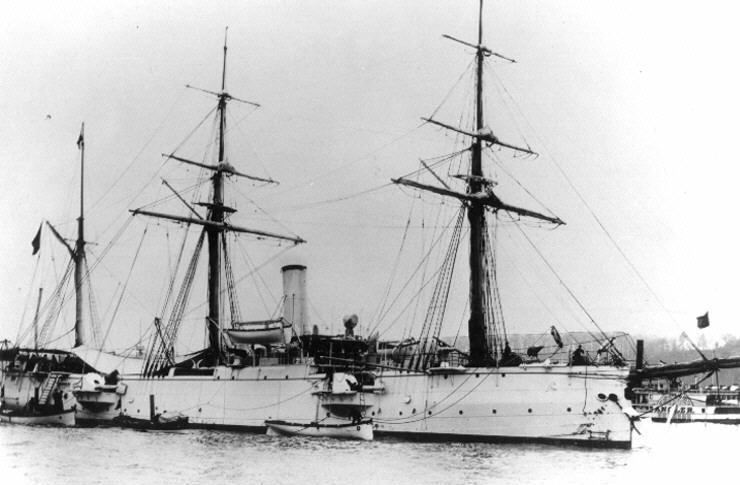Laid down 1883 Fate Sunk 1 May 1898 Launched 23 January 1887 Builder Province of Cádiz | Namesake Antonio de Ulloa Completed 1889 Construction started 1883 Length 64 m | |
 | ||
Class and type | ||
Don Antonio de Ulloa was a Velasco-class unprotected cruiser of the Spanish Navy that fought in the Battle of Manila Bay during the Spanish–American War.
Contents
Technical characteristics
Don Antonio de Ulloa was built at La Carraca shipyard, Cadiz, Spain. Her keel was laid in 1883 and the vessel was launched on 23 January 1887. The ship was completed in 1889. She had one rather tall funnel. The cruiser had an iron hull and was rigged as a barque.
Operational history
Not long after her completion, Don Antonio de Ulloa was sent to the Caroline Islands in 1890 to counter threats by the German Empire to those Spanish-owned islands. Later that year she was sent to the Philippines and was based there to replace her sister ship Gravina, which had been lost in a typhoon in 1884.
Don Antonio de Ulloa took an active part in Spanish military action against Philippine insurgents during the "Tagalog Revolt" (1896–1897), the Spanish name for the first two years of the Philippine Revolution. Among her more notable contributions was the transportation of Spanish Army landing forces to Zamboanga in 1897.
Her machinery was in such bad condition by the spring of 1898 that it was removed to be overhauled. With her immobilized off Cavite in Manila Bay, her port battery was also removed for use in reinforcing shore batteries. She was left with only her starboard battery aboard, and only about half of her crew, which was enough to man that battery.
She was in this condition when the Spanish–American War broke out in April 1898, and was anchored as part of the squadron of Rear Admiral Patricio Montojo y Pasarón in Manila Bay. Her anchorage was behind Sangley Point, where the Spanish hoped that the low, sandy point would provide some protection to her hull if the U.S. Navy attacked the anchorage.
The U.S. Navy's Asiatic Squadron under Commodore George Dewey did attack, early on the morning of 1 May 1898, making a series of slow firing passes at the Spanish squadron in the Battle of Manila Bay. During Dewey's first pass, Don Antonio de Ulloa took a few hits, the most destructive being a large shell that burst on the upper deck and killed nine men—among them her commanding officer—and wounded another ten, leaving almost no one aboard to man her remaining guns. There was also no one able to strike her colors; when Dewey's squadron reversed course and made a second firing pass, they assumed the still-flying battle ensign meant that Don Antonio de Ulloa was still in action. The U.S. squadron riddled the helpless ship, and she sank in shallow water; after the battle, her hull alone was found to have been holed by four 8-inch (203 mm), three 6-inch (152 mm), one 5-inch (127 mm), and 25 47 mm (1.9 in) and 37 mm (1.5 in) shells.
After the battle, a boarding party from gunboat USS Petrel went aboard and set the wreck of Don Antonio de Ulloa on fire. Postwar, a U.S. Navy survey team found her to be beyond salvage, and her wreck was broken up for scrap.
